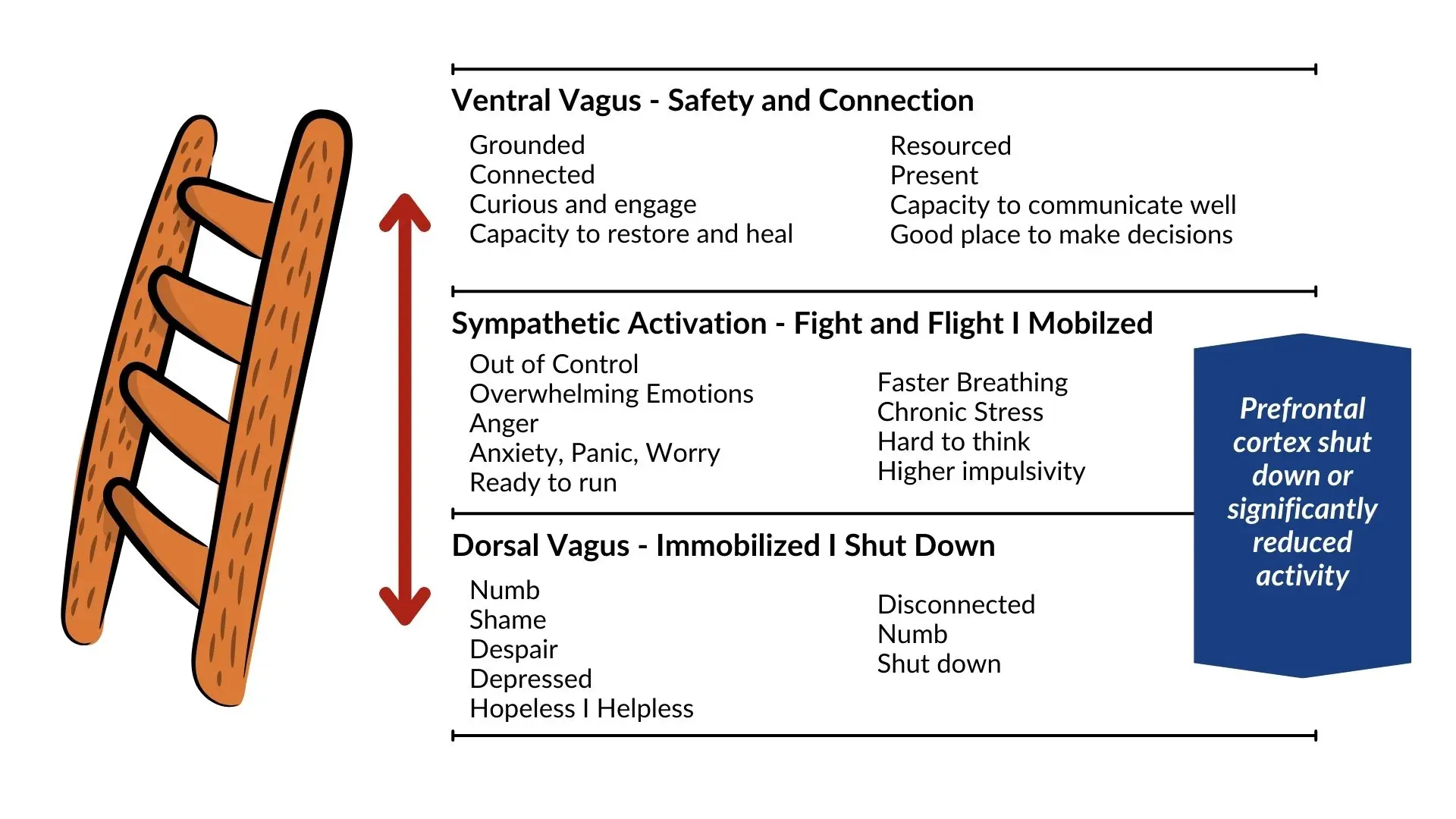Welcome to “Trauma Demystified,” a podcast brought to you by Bright Horizon Therapies. I am Natalie Jovanic, and I will be your host as we explore the world of Polyvagal theory for trauma.
Throughout today’s episode, we will delve deep into the complexities of Polyvagal theory, shedding light on its role in our nervous system’s response to various situations. While it simplifies the complicated processes that happen in our bodies, this theory provides invaluable insight into understanding trauma and the responses of the nervous system.
Our exploration will not only cover the influence of Polyvagal theory on trauma but also focus on the journey toward recovery. Furthermore, I will provide you with practical tools to maneuver through the diverse states of your nervous system effectively. Stay tuned to uncover the essential elements for recovering from trauma.
Introduction to Polyvagal theory for trauma
How did I find out about Polyvagal Theory? I became aware of polyvagal theory when I participated in a training on attachment and dissociation. I was curious and wanted to learn more. Therefore, I attended a training about polyvagal theory by Deb Dana because her name had been mentioned in the previous training.
When she guided the group through the different experiments, it finally made a click in my brain: I suddenly understood the various responses of my nervous system after I had experienced systemic trauma. At this stage, I frequently had a freeze response when attending large group gatherings. I couldn’t fully understand why my nervous system responded this way. However, when I was in training in Polyvagal theory, I understood that being part of groups was a cue of danger for my autonomic nervous system after an experience of systemic trauma. This understanding helped me immensely in my recovery. It wasn’t an unexplainable symptom anymore, but I could control how I wanted to respond to it. I found tools to manage my nervous system’s response and worked on my boundaries to protect myself.
What is Polyvagal Theory?
Dr. Stephen Proges developed the Polyvagal theory, a framework that helps us understand how our autonomic nervous system regulates its responses to stress and safety.
In this theory, the vagus nerve – one of the major nerves in the Autonomic nervous system, plays a crucial role in our emotional and physiological states.
To give you some background information: The autonomic nervous system manages vital internal organs and glands that are vital for daily living. For example, it controls the heart, the lungs, and the digestive system. The processes happen automatically, outside our conscious control, which means we don’t have to think about them.
The autonomic nervous system is split into the sympathetic and parasympathetic nervous systems. The sympathetic part manages the flight-and-fight response, while the parasympathetic part controls our “rest and digest” functions.
How does the vagus nerve relate to this? The vagus nerve is one of our bodies’ primary nerves. It starts at the back of our skulls —the medulla oblongata and runs through our bodies. It is split into the dorsal vagus and the ventral vagus. In Polyvagal Theory, the dorsal vagus is connected with the system of immobilization, i.e., the freeze response and the fawn response. The ventral vagus activation is linked to social engagement and the system of safety and connection.
3 Key principles of Polyvagal Theory
Polyvagal theory is based on three fundamental principles: hierarchy, neuroception and co-regulation.
Neuroception
Let’s look first at Neuroception: Neuroception is the process by which our autonomic nervous system constantly scans for cues of safety, danger, and life threats. This happens automatically and outside of our conscious awareness. Our nervous system listens for these cues in our environment, our relationships, and within our bodies.
For instance, while recording this podcast, my autonomic nervous system scans for these cues. If I were to hear a fire alarm, it would be a cue of danger, and my system would shift into a protective state, prompting me to take action. Similarly, as you listen to this podcast, your autonomic nervous system is also on the lookout for cues of safety or threat. If it perceives a danger cue, it will respond accordingly.
Neuroception – Examples
Here are some practical examples: if I walk down the street and witness two people aggressively yelling at each other, it might be a cue of danger for my autonomic nervous system, and I may experience a fight-or-flight response.
In case I work with a client who has experienced trauma due to emotional abuse and I use a word that the abuser used, it could be a cue of life threat for the client’s autonomic nervous system, and they may experience a fawn response.
If an individual works in a workplace that runs at a high speed and doesn’t allow people to say no, this could be a cue of danger for the individual. However, if they think that they’ll never find another job at a different place or are afraid to lose the job, it might also be a cue of life threat for the individual’s autonomic nervous system.
Overall, our nervous systems are shaped by our experiences. Therefore, each of us has different cues of safety, danger, or life threat. As a result, we need to be curious about our experiences and explore these cues. Ideally, our autonomic nervous system flows through these stages fluently and returns to safety and connection when the threat ends. However, it may look different if we have experienced trauma. I’ll come to it later. Befriending our autonomic nervous system and making the unconscious process conscious is a part of trauma recovery.
Hierarchy
Let’s look at the second core principle of polyvagal theory: Hierarchy. In contrast to the window of tolerance, polyvagal theory describes a hierarchy of responses, often visualized as a ladder:
The top of the ladder corresponds to Ventral Vagus activation, the middle is the system of mobilization or fight-and-flight, and the bottom is immobilization or shutdown.
The top of the ladder: Ventral Vagus activation
Ventral vagus activation – the top of the ladder is the system of safety and connection. When we are in this state, we can restore and grow. We can also regulate—individually or interactively and socially engage. When we are in a ventral vagus response, we feel connected to ourselves and the world around us.
Middle of the ladder: Mobilization
If a cue of danger is detected, the autonomic nervous system activates the fight-and-flight response—we are now in the middle of the ladder. We protect ourselves through action, aggression, or active escape in this state.
Bottom of the ladder: Immobilization (Dorsal vagus activation)
If a cue of life thread is perceived, the system of immobilization gets activated, also known as the freeze or fawn response. This means we protect ourselves by conserving our energy, shutting down or dissociating.
Example
Imagine starting in a state of safety and connection (ventral vagus activation). Suddenly, the nervous system detects a cue of danger and mobilizes fight-and-flight. However, the risk increases rapidly and becomes a cue of life threat. The autonomic nervous system moves into a state of immobilization (or dorsal vagus activation). To return to safety, the nervous system usually moves back through these stages: from immobilization to mobilization and then back to safety and connection.
So that you know, each nervous system is shaped differently. Some people (myself included) go very quickly into the immobilized state, while others stay very long in the fight-and-flight state.
Co-regulation
Co-regulation is the third principle of polyvagal theory. It describes how interactions with others shape and regulate our autonomic nervous system. Essentially, our nervous systems constantly send and receive cues of safety or danger, which profoundly influence our relationships.
When cues of danger are present, there are two primary responses:
- Reactivity: This can intensify habitual survival patterns and escalate conflict. For example, in a couple’s argument, if one partner responds with a freeze response while the other reacts with a fight response, and they do not recognize or manage these states, their reactivity can escalate, reinforcing their survival patterns and heightening tension.
- Co-regulation: This involves the ability to regulate ourselves and each other, fostering safety and creating new possibilities. If both partners become aware of their states and use practices to self-regulate and co-regulate, they can transform their interactions and build a healthier relationship.
Co-regulation is also crucial in a therapeutic context. When a client experiences states of mobilization or immobilization, the counsellor must be attuned to their autonomic state and engage in co-regulation. This mutual regulation supports the client in developing their self-regulation skills and enhances the therapeutic relationship.
Personal insight about Polyvagal theory for trauma
Here is one of my insights about polyvagal theory: When I first experimented with Polyvagal theory, I created my Polyvagal map in a workshop by Deb Dana. Understanding that the state of my nervous system influences how I perceive the world has been transformative. For example, the world may seem dark and disconnected when I am in a fawn response, whereas it appears full of opportunities in a ventral vagus activation. Therefore, the story I create about the world, my life and myself is very different, depending on the state I am in. This helped me to recognize that if I changed the states, it would also transform my emotional experience.
Client experiment
In sessions, I often guide clients through a similar awareness exercise to explore how the different states feel in their bodies and their beliefs about themselves and the world in each state. This exercise also allows my clients to experience how it is to move from a state of immobilization through the system of mobilization into the system of safety and connection. Clients often discover a new sense of control over their nervous system states. Many clients share similar insights to those I have experienced, revealing the profound connection between our physiological states and how they see the world.
Difference between Polyvagal Theory and the Window of Tolerance
Before I explore more about polyvagal theory for trauma, let’s look at the differences between polyvagal theory and the concept of window of tolerance – which I explained in an earlier episode. I’ll drop a link in the description. While there are parallels between both theories in the different states of responses, there are also differences.
Polyvagal theory focuses on the role of the vagus nerve in regulating physiological responses and emotional states. Furthermore, it looks at the interdependencies between cues and emotional states. Therefore, it explores the interconnectedness between a physicological response and specific triggers more deeply.
The concept of window of tolerance speaks about the states; however, it focuses more on how an individual can effectively manage and process intense emotions. It doesn’t look at the cues of safety or danger. It describes how individuals can have a zone of tolerance where they can effectively manage emotions without being overwhelmed or shutting down. The window of tolerance represents our capacity to handle stress without looking at the context of what activated our response.
Example
Here is an example of how these concepts correlate: a client experienced a fawn response during the session. They recognized the response, and we used a grounding exercise to get them back into their window of tolerance. This is an example of how to apply the window of tolerance. When they were back in their window of tolerance, we explored which signs of danger activated their nervous system. We discovered that my action of asking questions was a cue of danger for their nervous system and activated the immobilization response (which is part of the polyvagal theory). The act of asking questions is an act of power. Due to the inherent power imbalance in the therapeutic relationship, it can even have a more profound impact. Due to this new insight, I adjusted my approach so that the client could go through the therapeutic process without a fawn response.
During this experience, I focused on staying connected to my state of safety and connection so that my autonomic nervous system could offer the client a sense of co-regulation—an example of how to apply Polyvagal theory.
Polyvagal Theory for trauma
Let’s look at how Polyvagal theory explains trauma.
To be clear, even if we don’t have experienced trauma, we cannot always be in a state of safety and connection, so it’s natural to go up and down the ladder. However, we ideally flow back into that state after the threat is over.
However, If we experience trauma, it can interrupt the balance and natural flow between the different states. This means that the autonomic nervous system can get stuck in a response mode—whether it is the system of mobilization or immobilization. Even though the actual threat is gone, the body perceives danger. Therefore, the response modes of mobilization or immobilization stay engaged. As a result, the individual may experience a chronic fight or flight response or a chronic shutdown. Sometimes, they switch frequently between sympathetic arousal and dorsal vagus activation; however, they hardly ever go into a state of safety at the top of the ladder.
Influence of childhood trauma on safety and connection
For many adults who have experienced childhood trauma, the state of safety and connection may seem out of reach. Due to my childhood trauma, I only experienced a state of safety and connection as a young adult when I was alone with animals or in nature. Some clients can hardly remember if they ever experienced safety and connection. If this is the case, it is an essential goal of trauma counselling to find practices to connect with the state of safety and connection over time. This is an inner process that requires patience and persistence.
Other dynamics that may provoke a state of mobilization or immobilization are connected with our internal dialogue and parts that hold trauma wounds. As explained before, there is a risk that we experience inner fragmentation after trauma. If some intense parts take over, it can dysregulate our nervous system. This can be either self-blaming parts, parts with self-hatred or parts with punitive voices.
Structural dissociations and Polyvagal Theory
Since I discussed the theory of structural dissociations in my last episode, the previous example also explains how the two theories can connect. Common parts associated with structural dissociations are the flight, fight, freeze, and fawn parts. Depending on what happened to us, I find it beneficial to integrate polyvagal theory into parts work therapy as an additional framework to explain trauma responses. Our lived experience is often more complex than a simplified version of a theory can explain. For example, some people may experience a part in a fawn response and another in a flight response. At the same time, there is still a tiny percentage of connection with the system of safety and connection.
The cues of danger and life threats for our nervous system can vary and depend from person to person. Furthermore, each nervous system is shaped differently. Curiosity to get to know our nervous system is essential in the healing process. Please note that these responses don’t mean you are broken, or something is wrong with you. They are adaptive coping mechanisms that have allowed you to survive extreme circumstances. We can reshape our autonomic nervous system in our recovery journey.
Role of Polyvagal Theory in trauma recovery
As with any theory, Polyvagal theory can help us better understand how trauma affects our autonomic nervous system and make sense of complex inner processes. However, the critical part is to find practices to apply the theory to one’s life since the theory alone won’t change the symptoms. In work with my clients, polyvagal theory serves as one cornerstone of treatment, alongside EMDR, parts work therapy, and other trauma treatment modalities, so it’s an integrated approach. If you want to learn more about IFS and EMDR, check out the article “IFS and EMDR: Which one is better for trauma recovery.”
Polyvagal theory can support us to re-establish safety and connection
The first stage of trauma recovery is safety and stabilization. Polyvagal theory can help us recognize if we are stuck in a state of mobilization (fight and flight) or immobilization (shutdown). I usually guide my clients through a process so that they become aware of how the different states feel in their bodies. This allows them to recognize them more quickly later on. Additionally, we use various practices to bring the client back to a state of safety and connection.
Therapeutic relationship as a place for co-regulation
Co-regulation, one of the core principles of polyvagal theory, explains that the counsellor plays an active role in the healing process. They need to be attuned to their autonomic nervous system to be able to co-regulate with a client if their nervous system dysregulates. The therapist’s calm and grounded presence can model and support the client’s journey toward self-regulation, helping them to feel more secure and connected, even when processing difficult emotions and memories. This co-regulation can be a powerful tool in rebuilding the client’s capacity for trust and connection with others. Please note that counsellors aren’t perfect and may sometimes become dysregulated. When this happens, it is the counsellor’s responsibility to regulate themselves, offer an apology, and make a repair bid to the client.
Personalized trauma treatment
Polyvagal theory offers a framework to understand how different individuals respond to trauma based on their autonomic nervous system’s unique shaping. It allows us to use a personalized approach to trauma counselling and explore the unique cues of safety or danger an individual may experience. By tailoring interventions to the individual’s nervous system, therapists can help clients build resilience and gradually expand their window of tolerance, allowing them to better manage stress and emotional regulation over time.
Please remember that it’s a common misconception that healing means always being in a state of safety and connection. This is impossible. Healing comes in stages. The ideal outcome is for our autonomic nervous system to return to the top of the ladder—the state of safety and connection—once the threat has passed. However, healing is a process, and improvement happens over time. It can be helpful to set more realistic goals, such as experiencing a state of safety and connection 10% more often, or if an individual’s autonomic nervous system tends to stay in fight-or-flight mode for six weeks, aiming to reduce that period to five weeks.
Practical Techniques for regulating the nervous system
After all this theory, here are some practical steps to apply Polyvagal theory to your life:
Practice curiosity about your autonomic nervous system.
Deb Dana beautifully describes this as “befriending your nervous system.” Keep a journal about your day and explore what state your nervous system was in at different times:
- When did you go into sympathetic activation or fight-and-flight?
- At what moment did you experience immobilization?
- When did you feel a sense of safety and connection?
As you identify these moments, explore the cues of danger and safety that activated different states in your autonomic nervous system.
Create a list of your ventral anchors
These tools help you return to and maintain a state of safety and connection.
Here are some examples of how to find ventral anchors. Please choose those that resonate and leave the rest:
Find memories that bring you back to a state of safety and connection
Reflect on a memory when you felt safe and connected. Close your eyes and recall this memory with all your senses, embodying the experience. Writing down the details—when and where it happened, who you were with, what you were doing, and how you felt—can deepen the connection. Practice embodying this memory twice a day and observe the shift in your nervous system.
Find activities that bring you back to a state of safety and connection
Certain activities can help you return to a state of safety and connection. These activities vary for everyone, so choose what resonates with you. It could be walking in nature, enjoying a coffee, or cooking. For example, I love to dance to shift out of a freeze response and into safety and connection. Going to the zoo is another activity that works for me. Consider how you can incorporate these activities into your life.
Find people or pets who give you a state of safety and connection
For some, it’s easy to identify people who provide safety and connection; for others, it may not feel safe. If this idea doesn’t resonate with you, skip it. That’s okay. Reflect on who gives you a sense of safety and connection, and consider how you can reach out or connect with them when feeling dysregulated. For instance, a training group in Barcelona is a vital ventral anchor for me. Though I can’t connect with them physically anymore, I visualize their presence. For some people, pets or animals can also serve as powerful ventral anchors.
Grounding exercises
Grounding exercises can help you return to a state of safety and connection, especially when emotions are heightened. Try the 5-4-3-2-1 grounding technique if you feel overwhelmed: identify five things you can see, four things you can touch, three things you can hear, two things you can smell, and one thing you can taste.
If you want more tools, please check out the episode about the window of tolerance.
Understanding and applying Polyvagal theory can be a powerful tool in your trauma recovery journey, helping you recognize and navigate the states of your autonomic nervous system. Integrating these practical techniques into your daily life allows you to gradually cultivate a greater sense of safety and connection, even amidst life’s challenges. Remember, healing is a process, and with patience and persistence, you can reshape your nervous system to support your ongoing growth and resilience.
Thank you for listening to today’s episode. If you enjoyed the content and found it helpful, please consider subscribing and liking the podcast to stay updated with future episodes. Your support helps us continue to share valuable insights and resources on the journey to healing and connection. I hope to connect with you soon. Take care!
Sources
This article is informed by my professional training, lived experience in trauma recovery, ongoing study, professional practice, and the works of trusted authors and organizations in trauma recovery, mental health, and social justice. The references below include the books, trainings, and evidence-based resources that shaped the ideas discussed here:
Deb Dana. (2022). Deb Dana’s Polyvagal Informed Therapy master class: With special guest Stephen Porges, PhD [Online course]. Psychotherapy Networker.
Davis, E., & Marchand, J. (2021). Attachment and dissociation assessment and treatment [Online professional training]. R. Cassidey Seminars





